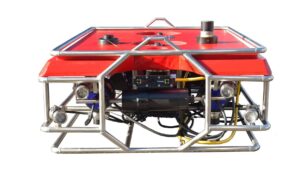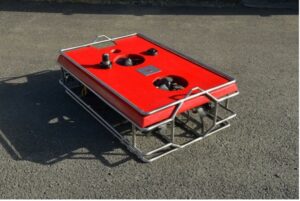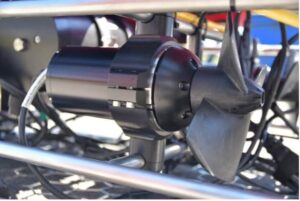
Mariscope Meerestechnik has launched a powerful new Observation Class/Light Work Class ROV. Characterised by speed and manoeuvrability, the new ROV is equipped with Mariscope’s latest thrusters, providing greater flexibility and the ability to operate in adverse situations, such as high current conditions.
The Flunder, in its standard version, incorporates six new-generation thrusters with a power of 400 W each, with a vectorized distribution (4 horizontal and 2 vertical) and a modified control system. The power of the motors can be increased on demand up to 900 W each.
These features, together with its low profile that reduces its hydrodynamic resistance (its dimensions are 100 x 120 x 40 cm), gives it a speed of 3-5 knots and excellent performance in all kinds of conditions, whilst reducing displacement and underwater inspection times significantly.
The robust AISI 316L stainless steel structural chassis, hand welded (TIG) and crystal blasted, gives the ROV enormous strength and ruggedness and provides a firm base for the attachment of additional accessories without compromising the structure.
The Thrusters
Features and benefits of the new-generation thrusters include:
 Brushless thrusters have a higher efficiency and motor speed:torque ratio, enabling a greater dynamic response, longer service life and lower maintenance.
Brushless thrusters have a higher efficiency and motor speed:torque ratio, enabling a greater dynamic response, longer service life and lower maintenance.- Robust, rugged housings made of marine aluminium with a black anodized coating, and a sacrificial zinc anode.
- Magnetic coupling system for power transmission from the engine to the propellers, eliminating the drive shafts. Eliminating the shaft seals converts the motor housing into a totally watertight compartment and eliminates the risk of water ingress due to seal breakage or wear.
- Electronic protection from a KFU that cuts power to the thruster in case of overloads or blockages, protecting the ROV and the motor from further damage.
- Smaller size due to design characteristics making the motors more compact.
- Increased power and greater efficiency despite their reduced size.
- Lower maintenance requirements even under the harshest conditions due to the absence of moving shaft seals, improving robustness and increasing service life.
- Increased efficiency enabling greater thrust power without increased consumption.
Equipment & Payloads
 The Flunder’s modular structure allows for equipment expansion and instruments to be carried on board, even in a second phase after the initial acquisition. Buoyancy can be varied at any time and the payload adjusted.
The Flunder’s modular structure allows for equipment expansion and instruments to be carried on board, even in a second phase after the initial acquisition. Buoyancy can be varied at any time and the payload adjusted.
The Flunder has high-resolution Full HD cameras with built-in laser pointers, and LEDs attached in the 160° tilt mechanism and externally, all housed in robust saltwater-resistant aluminium housings with an anodized surface.
The ROV can easily be equipped with additional lights to customize and optimize the illumination of the desired viewing angle. These external lights are attached to the chassis by means of specially designed brackets fitted to the ROV frame.
Sensors include; Depth Gauge, Compass, ROV and Tilt Mechanism inclination sensor, ROV Power Consumption as well as a full range of automatic functions; Auto Depth/Auto Dive/Auto Head, Automatic Tilt Correction to maintain the observed horizon.
Depth & Buoyancy
The structural design and manufacture of this robot enables it to reach a working depth of 1,000 meters, and the on-require version for this depth will be equipped with the appropriate buoyancy for it. However, the Flunder will be marketed, in standard version, with buoyancy for 500 meters depth in order to reduce the cost for customers whose jobs do not require reaching greater depths.
It is equipped with video and wireless control console installed in Pelican cases, making the system highly transportable and flexible. Its video console has an industrial computer and SSD storage unit, enabling recording of up to 500 Gb of Full HD transmission from the ROV cameras.
A self-regulating power supply unit (PSU), which automatically regulates the voltage loss of the umbilical cable, ensures delivery of maximum power and greater motor efficiency.
Find suppliers & manufacturers of Remotely Operated Vehicles (ROV) >>




 Brushless thrusters have a higher efficiency and motor speed:torque ratio, enabling a greater dynamic response, longer service life and lower maintenance.
Brushless thrusters have a higher efficiency and motor speed:torque ratio, enabling a greater dynamic response, longer service life and lower maintenance.













